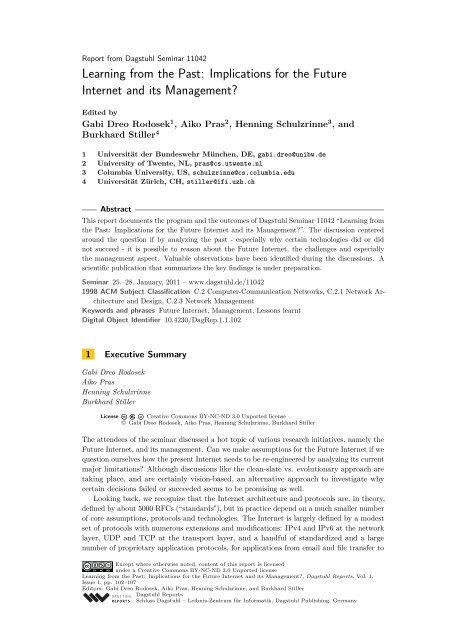Volume 1, Issue 1, January 2011 - DROPS - Schloss Dagstuhl
Volume 1, Issue 1, January 2011 - DROPS - Schloss Dagstuhl
Volume 1, Issue 1, January 2011 - DROPS - Schloss Dagstuhl
Create successful ePaper yourself
Turn your PDF publications into a flip-book with our unique Google optimized e-Paper software.
Report from <strong>Dagstuhl</strong> Seminar 11042<br />
Learning from the Past: Implications for the Future<br />
Internet and its Management?<br />
Edited by<br />
Gabi Dreo Rodosek 1 , Aiko Pras 2 , Henning Schulzrinne 3 , and<br />
Burkhard Stiller 4<br />
1 Universität der Bundeswehr München, DE, gabi.dreo@unibw.de<br />
2 University of Twente, NL, pras@cs.utwente.nl<br />
3 Columbia University, US, schulzrinne@cs.columbia.edu<br />
4 Universität Zürich, CH, stiller@ifi.uzh.ch<br />
Abstract<br />
This report documents the program and the outcomes of <strong>Dagstuhl</strong> Seminar 11042 “Learning from<br />
the Past: Implications for the Future Internet and its Management?”. The discussion centered<br />
around the question if by analyzing the past - especially why certain technologies did or did<br />
not succeed - it is possible to reason about the Future Internet, the challenges and especially<br />
the management aspect. Valuable observations have been identified during the discussions. A<br />
scientific publication that summarizes the key findings is under preparation.<br />
Seminar 25.–28. <strong>January</strong>, <strong>2011</strong> – www.dagstuhl.de/11042<br />
1998 ACM Subject Classification C.2 Computer-Communication Networks, C.2.1 Network Architecture<br />
and Design, C.2.3 Network Management<br />
Keywords and phrases Future Internet, Management, Lessons learnt<br />
Digital Object Identifier 10.4230/DagRep.1.1.102<br />
1 Executive Summary<br />
Gabi Dreo Rodosek<br />
Aiko Pras<br />
Henning Schulzrinne<br />
Burkhard Stiller<br />
License Creative Commons BY-NC-ND 3.0 Unported license<br />
© Gabi Dreo Rodosek, Aiko Pras, Henning Schulzrinne, Burkhard Stiller<br />
The attendees of the seminar discussed a hot topic of various research initiatives, namely the<br />
Future Internet, and its management. Can we make assumptions for the Future Internet if we<br />
question ourselves how the present Internet needs to be re-engineered by analyzing its current<br />
major limitations? Although discussions like the clean-slate vs. evolutionary approach are<br />
taking place, and are certainly vision-based, an alternative approach to investigate why<br />
certain decisions failed or succeeded seems to be promising as well.<br />
Looking back, we recognize that the Internet architecture and protocols are, in theory,<br />
defined by about 5000 RFCs (“standards"), but in practice depend on a much smaller number<br />
of core assumptions, protocols and technologies. The Internet is largely defined by a modest<br />
set of protocols with numerous extensions and modifications: IPv4 and IPv6 at the network<br />
layer, UDP and TCP at the transport layer, and a handful of standardized and a large<br />
number of proprietary application protocols, for applications from email and file transfer to<br />
Except where otherwise noted, content of this report is licensed<br />
under a Creative Commons BY-NC-ND 3.0 Unported license<br />
Learning from the Past: Implications for the Future Internet and its Management?, <strong>Dagstuhl</strong> Reports, Vol. 1,<br />
<strong>Issue</strong> 1, pp. 102–107<br />
Editors: Gabi Dreo Rodosek, Aiko Pras, Henning Schulzrinne, and Burkhard Stiller<br />
<strong>Dagstuhl</strong> Reports<br />
<strong>Schloss</strong> <strong>Dagstuhl</strong> – Leibniz-Zentrum für Informatik, <strong>Dagstuhl</strong> Publishing, Germany













